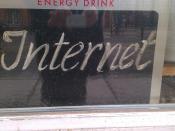The sign at Wal-Mart says, "99 Cents." Although, if you go through the checkout line and greet the cashier with merely a dollar, the cashier would laugh at you. The price isn't ninety-nine cents, it's $1.06. The taxman at our friendly Raymore Wal-Mart claims an additional 7.45% of one's hard earned dollars. The additional seven cents doesn't sound like much, but it is when it's seven additional cents for each dollar of the thousands of dollars that a person spends at a business like Wal-Mart every year. These seven-cent deposits go to the Missouri and Raymore tax funds. Taxes that help pay for public education, Medicaid, and other state and local services (Alster). There is only one problem, a new form of commerce is taking business away from normal "brick and mortar" businesses like Wal-Mart. This form of commerce isn't new, it's actually a few years old and it's growing exponentially now.
This new standard of commerce is called "electronic commerce" or "e-commerce." E-commerce comprised of $4 billion dollars in revenues in 1997 ("Let's Not Rush"), which is almost negligible to the trillions of dollars done in total revenues in the United States. Although, it is forecasted to be much more popular in the future. Shopping on the Internet has many benefits over shopping in local stores.
E-Commerce, or electronic commerce, is commerce done over the Internet. The Internet is seen as the future for business and information technologies. Why would a person want to spend a few minutes getting dressed to drive fifteen minutes to Wal-Mart to spend an hour or two shopping, and another half an hour, on a good day, checking out and driving back home. In the middle of all that, don't forget the hassle of trying to find the right toy, while listening to obnoxious...


